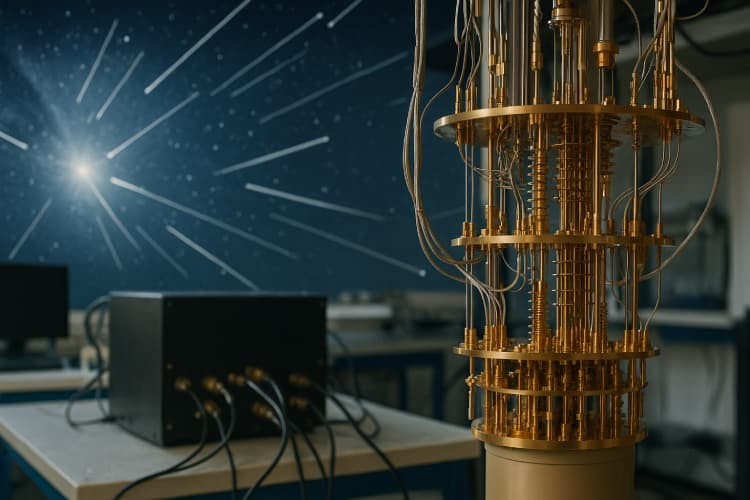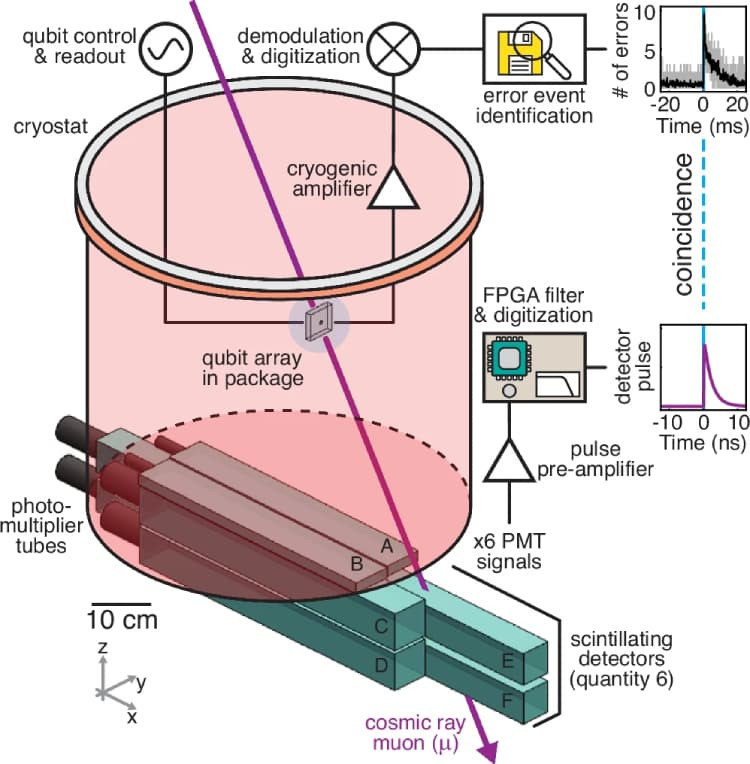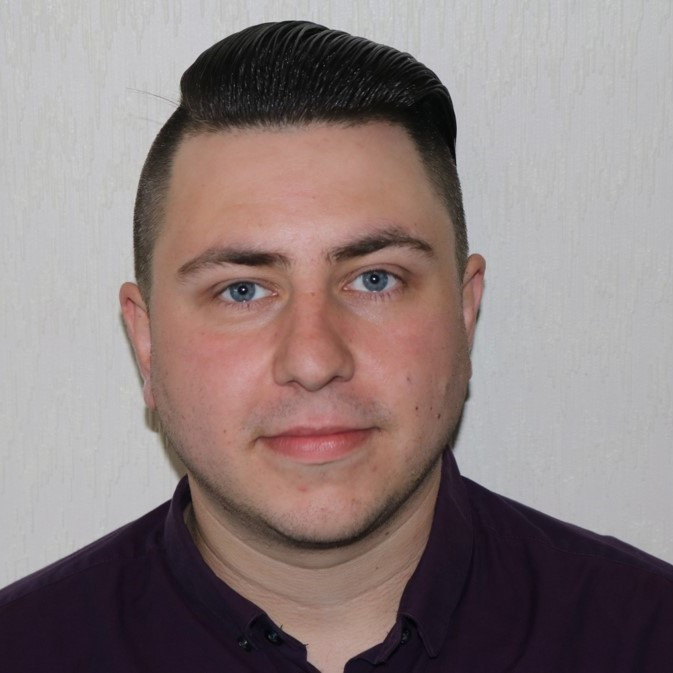Cosmic Rays Impact on Quantum Computing Stability
Insights | 06-10-2025 | By Liam Critchley

Key Things to Know:
- Cosmic and terrestrial radiation can cause correlated errors in superconducting qubits, disrupting quantum coherence and circuit stability.
- Recent research confirms that cosmic rays account for around 17% of correlated qubit errors in superconducting quantum processors.
- Shielding methods such as underground placement and lead barriers can mitigate terrestrial radiation—but cosmic radiation remains difficult to block.
- Future solutions include qubit hardening techniques like semiconductor gap engineering, phonon trapping, and radiation-resistant hardware design.
Building quantum technology that can process quantum information at scale is going to require stable and long-lived quantum bits (qubits). It is likely that quantum technology will be enabled by error-correction codes, but many superconducting qubit experiments have discovered that correlated errors pose an issue for conventional codes.
It’s thought that the sources of these errors are ionising radiation from cosmogenic and terrestrial sources, as these are always present in laboratory environments. Cosmogenic radiation includes cosmic rays, as well as other particles, including muons and neutrons, that come to Earth as a continuous flux of high-energy ionising radiation. Terrestrial radiation includes gamma rays that are generated from potassium, uranium and thorium decay chains. These can all be found in the laboratory, ranging from the concrete in the walls to metal fixtures and printed circuit boards (PCBs).
Terrestrial radiation can be ablated using lead shielding and through actively choosing low radioactivity materials. However, cosmogenic radiation travels with such a high momentum that it is very difficult to shield and presents a big challenge for solid-state quantum processors.
Impact of Radiation on Quantum Technology
Ionising radiation can change the quantum coherence and electrical response of superconducting circuits because it ionises the atoms within the circuit substrate. This generates high-energy electron-hole pairs that cascade when they relax, leading to electron-hole recombination, the generation of secondary charge carriers, and the release of phonons. A portion of the energy that hits the substrate gets transferred to the superconducting circuit, generating non-equilibrium quasiparticles that affect the performance of the circuit.
The effect of quasiparticles and ionising radiation on the performance of superconducting circuits has been widely studied—especially for quantum information processing applications. For example, manufactured radioactive radiation sources have been shown to have excessive levels of ionising radiation, which increase the average energy-decay rate of superconducting transmon qubits (designed to have a reduced sensitivity to noise) and increase the rate of quasiparticle-induced phase slips in fluxonium qubits (qubits with longer coherence times).
Studies have shown that lead shields can reduce qubit decay rates, and performing the operations underground (where there is a lot of Earth to block cosmic radiation and less terrestrial radiation) has been found to reduce the rate of quasiparticle bursts and phase slips.
It’s also been found that ionising radiation is responsible for:
- Spatiotemporally correlated anomalies in multiqubit arrays—such as correlated charge-offsets
- Increase in the rate and energy of chip-scale failure events
- Inhibiting the decoding of quantum error detection protocols
New Study Shows Cosmic Ray Radiation Can Impact Quantum Technology
While ionising radiation has long been linked to spatiotemporally correlated qubit errors, researchers had not directly proven whether terrestrial or cosmogenic radiation was responsible for chip-scale superconducting qubit failures. Until recently, this had only been inferred through modelling and simulation. A new experimental study has now provided clear evidence connecting cosmic rays to correlated quantum errors, confirming what theorists have long suspected.
Direct Evidence Linking Cosmic Rays to Qubit Errors
To visualise how researchers traced cosmic particles to qubit instability, the study included a synchronous detection setup combining superconducting qubit readouts with nearby cosmic-ray sensors. This arrangement allowed precise correlation between particle strikes and multi-qubit relaxation events.

In the study, researchers monitored a 10-transmon qubit array distributed across a 5 × 5 × 0.35 mm³ silicon chip for over 266 hours. They synchronised qubit energy-relaxation measurements with data from six scintillating cosmic-ray detectors placed beneath the cryostat. This approach enabled the team to observe coincident events between cosmic radiation and correlated qubit relaxation, effectively tracking the impact of cosmic particles on superconducting circuits.
The results were striking. Around 17.1 ± 1.3% of all correlated errors in the qubit array were directly linked to cosmic rays and their secondary particles, with the remainder primarily attributed to terrestrial gamma radiation. Unlike terrestrial radiation, which affected up to four qubits, cosmic rays impacted all ten qubits simultaneously. These findings closely matched computational models based on GEANT4 muon flux data, reinforcing the reliability of the observations.
How Cosmic Rays Affect Superconducting Circuits
The study also revealed that the superconducting gap near Josephson junctions significantly influences how qubits respond to cosmic radiation. Energy from incoming high-energy particles generates non-equilibrium quasiparticles, which degrade coherence and stability. Because shielding cannot fully block cosmic radiation—especially above ground—future systems may need to adopt radiation-hardened qubit designs.
Researchers recommend several engineering approaches to reduce cosmic-ray sensitivity without relocating systems underground, including:
- Semiconductor gap engineering around Josephson junction electrodes to reduce quasiparticle bursts
- Phonon and quasiparticle trapping techniques to capture and dissipate excess energy
- Inhibiting quasiparticle tunnelling through advanced material layering
While underground placement remains the most effective way to eliminate cosmic-ray interference, it is impractical for large-scale commercial quantum systems. Therefore, radiation-hardening techniques and adaptive error-correction algorithms are expected to play a key role in future quantum hardware development.
Further studies will explore how ionising radiation affects two-level system density states, relaxation-time fluctuations, and quasi-static noise. These effects could influence the long-term reliability of quantum error correction, highlighting the ongoing need to design both hardware and software capable of mitigating radiation-induced correlated errors.
Reference:

